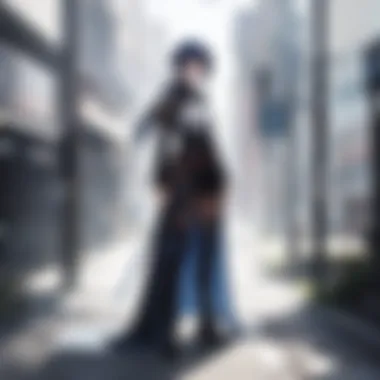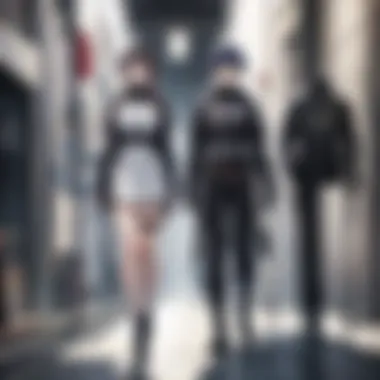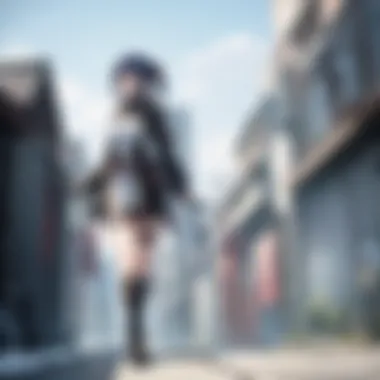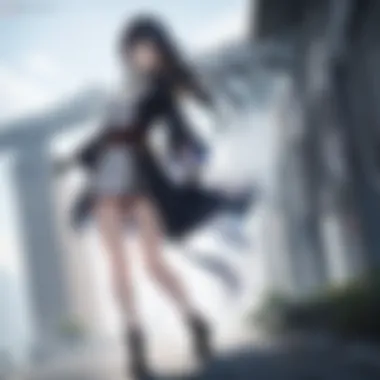Discovering MMO Games Inspired by Sword Art Online


Intro
Massively Multiplayer Online (MMO) games have revolutionized the gaming landscape by creating vast virtual worlds where players can interact, strategize, and forge connections. One notable influence within this world is the popular anime series Sword Art Online. This series not only captivates audiences with its thrilling narrative but also highlights the profound experiences that can emerge from online gaming. In this article, we will inspect games that share thematic and mechanical similarities with Sword Art Online, exploring their narratives, character dynamics, and the vibrant communities that breathe life into these gaming realms.
Character Analysis
Overview of Character Development
Character development within MMO games plays a critical role in engaging players and creating meaningful experiences. In games akin to Sword Art Online, characters often evolve through challenges, adversities, and interpersonal relationships that mirror growth arcs in well-crafted narratives. For instance, games such as Final Fantasy XIV and Guild Wars 2 allow players to fully develop their avatars, moving from novices to heroes influential in their lore.
Key Relationships and Dynamics
The interpersonal dynamics among characters are vital. These relationships often parallel the intricate bonds seen in Sword Art Online, where camaraderie and personal stakes run high. Players interact with a variety of characters, building relationships that can affect gameplay. In a title like Elder Scrolls Online, players may find themselves forming alliances or rivalries, which enhances the immersive experience.
"Relationships in MMO games transform virtual roles into a network of emotional investments, similar to relationships in traditional storytelling."
Thematic Exploration
Central Themes and Messages
When diving into the mechanics of games like Sword Art Online, some recurring themes emerge. The exploration of identity, mortality, and the consequences of technology are prominent in many stories. Such themes resonate deeply with players, as they navigate their avatars' journey through peril and discovery. The game worlds allow players to confront these themes personally and socially, reflecting on their experiences.
Cultural Context and Influences
The cultural backdrop of these games often amplifies their narratives. Many titles draw influence from Japanese culture and storytelling traditions, blending mythology with futuristic settings. This provides players with a unique lens to understand their characters and the world they inhabit. Titles like SAO Integral Factor illustrate this blend, showcasing familiar tropes while embedding them in a rich cultural context.
Preface to MMO Games
Massively Multiplayer Online games, commonly known as MMO games, represent a significant sector in the gaming industry. These games create captivating worlds where players can immerse themselves in vibrant environments filled with challenges and interactions. The relevance of examining MMO games in this article emerges from their growing popularity, particularly among fans of narrative-driven experiences like Sword Art Online. This genre not only entertains but also fosters connections among players, encouraging cooperation, competition, and socialization.
Definition of MMO Games
MMO games are defined by their capacity to support large numbers of players simultaneously within a shared virtual environment. Typically, these games involve role-playing elements, where players create avatars and embark on quests. The games merge complex storytelling with expansive gameplay, providing a platform for players to engage in cooperative missions or competitive activities. Some characteristics that define MMO games include:
- Large Scale Interaction: Players interact with thousands of others concurrently.
- Persistent Worlds: Game worlds continue to evolve even when the player is offline.
- Character Customization: Players can create unique avatars or characters.
- Quest Systems: Engaging storylines and missions guide player experiences.
Through this lens, a comprehensive understanding of MMO games sets the stage for exploring titles that mirror the essence of Sword Art Online.
The Appeal of MMO Games
The appeal of MMO games lies in their ability to blend social interaction with challenging gameplay. They cater to diverse interests, from casual players seeking leisurely experiences to hardcore gamers pursuing mastery and competitive edge. Key factors contributing to their popularity include:
- Community Engagement: Players can form bonds through guilds and teams, enhancing the collaborative experience.
- Diverse Content: Game worlds often provide varied quests, events, and challenges, ensuring ongoing engagement.
- Personal Growth: Character development systems allow players to enhance skills and abilities over time.
"MMOs are not simply games; they create communities and worlds where players can live, explore, and thrive together."
In essence, the multifaceted nature of MMO games enriches the gaming landscape by offering deeper narratives and immersive experiences for fans of Sword Art Online and other similar titles.
Sword Art Online: A Cultural Phenomenon
Sword Art Online, or SAO, stands at the intersection of anime, gaming, and popular culture. Its narrative explores the implications of virtual reality and the human experience within digital worlds. This exploration resonates with fans who are passionate about the potential of technology to create immersive experiences. Understanding SAO is crucial for comprehending the landscape of MMO games, particularly those that mimic its style and themes.


Overview of the Series
Sword Art Online debuted as a light novel in 2002, later evolving into an anime series that gained widespread acclaim. The story primarily follows Kirito, a player trapped within a hyper-realistic MMORPG. If players die in the game, they perish in real life. This premise creates a unique tension that drives the narrative forward. The series reflects on themes like friendship, survival, and the evolution of technology. With multiple arcs exploring different worlds, SAO showcases various gameplay mechanics and character relationships. Its ability to engage viewers allows for a deeper understanding of MMO game dynamics.
Impact on Gaming Culture
The influence of Sword Art Online extends beyond entertainment. It has shaped perceptions about virtual reality and gaming interactions. With its engaging narrative and character depth, SAO sparked interest in similar MMORPGs, inspiring game developers to create titles that incorporate immersive storytelling and complex character development.
The series demonstrated the potential of virtual worlds, making audiences think about the societal impacts of technology.
In addition to inspiring new game mechanics, SAO has fostered a thriving community of fans and gamers. Many players aspire to the connections depicted in the story, facilitating in-game friendships and collaborations. This sense of community is a key factor in why many MMO titles strive for a narrative style echoing that of Sword Art Online.
In summary, Sword Art Online is not just a show but a significant cultural touchstone for gamers and anime enthusiasts alike. Its exploration of virtual worlds emphasizes the importance of narrative in MMOs, making it integral to any discussion surrounding games similar to it.
Key Features of SAO-like MMOs
The significance of key features in MMO games similar to Sword Art Online is paramount. These games aim to provide immersive experiences that echo the intense drama and rich storylines found in the series. Understanding these features helps players identify what makes these games engaging and unique.
Narrative Style
Narrative style in MMO games serves as the backbone for player engagement. These games often feature intricate storylines that resonate with fans of Sword Art Online. The plots frequently explore themes of adventure, betrayal, and friendship. The ability to experience a deep narrative allows players to connect emotionally with the game world and its characters.
Many titles incorporate rich lore and detailed world-building, letting players feel they are part of a larger story. This is particularly true in games like Genshin Impact, where the narrative is woven throughout gameplay. Quest lines can be designed not only to progress but also to reveal character backstories and establish connections between players and the environment.
Gameplay Mechanics
Gameplay mechanics define how players interact with the game, shaping their experiences. In SAO-like MMOs, these mechanics often include action-based combat systems that demand skill and quick reflexes. Unlike traditional turn-based systems, action combat keeps players actively engaged, providing a sense of excitement.
Character customization is another crucial aspect. Players enjoy creating unique avatars with distinct abilities. This allows for varied playstyles, catering to preferences ranging from strategic gameplay to brute force. Notable mechanics also include leveling systems, crafting, and resource management. All these elements combine to create a dynamic gaming environment, making each session feel fresh and rewarding.
Multiplayer Interaction
The social component of MMO games cannot be overlooked. Multiplayer interaction fosters a sense of community, vital for maintaining player interest over time. Games that mimic Sword Art Online often emphasize teamwork through guilds and party systems. Players must collaborate to tackle difficult bosses, complete quests, or participate in large events.
This engagement is enhanced by user-generated content, where players contribute to the game’s narrative or environment. The presence of in-game events and competitions can also drive participation. These features cultivate an atmosphere of camaraderie and rivalry, vital for building long-term connections between players.
Ultimately, the collective elements of narrative style, gameplay mechanics, and multiplayer interaction create a cohesive experience that can mirror, if not surpass, the essence of Sword Art Online.
Recognizing these key features will equip players to choose the right MMO for their personal tastes and desired experiences.
Notable MMO Games Like SAO
In the exploration of MMO games that reflect the essence of Sword Art Online, it is vital to highlight the notable titles that have made significant impacts in this genre. These games not only offer engaging gameplay but also cultivate rich narratives and foster strong communities. For anime and manga enthusiasts, such experiences provide a deeper connection to the storylines they love, often allowing players to immerse themselves in fantastical worlds similar to that of Sword Art Online. By recognizing these key games, we can understand the diverse landscape of MMO gaming and its appeal to fans of the genre.
ALfheim Online
ALfheim Online serves as an important sequel to the Sword Art Online series within its own narrative universe. This game builds upon the lore established in the original series, introducing new mechanics and an elf-centric environment, which keeps the essence of SAO alive. The verticality of world design is notable, as players can fly, facilitating exploration and interaction that add depth to the gameplay.
The combat system has evolved, featuring an intricate blend of skills that encourage strategic teamwork among players. Additionally, the social aspects of ALfheim Online, such as guild interactions, present opportunities for players to recreate the friendships exhibited in the anime, enhancing the overall experience. The implementation of various races, each with unique skills, allows for customization and personal storytelling, which resonates well with fan expectations of detailed character development.
Sword Art Online: Fatal Bullet
Sword Art Online: Fatal Bullet stands out as a notable entry that leverages third-person shooting mechanics while firmly rooting itself in the SAO universe. This game deviates from classic MMO conventions by focusing on gunplay rather than melee combat, which brings a fresh perspective to the series. Players can create their avatars with extensive customization options, allowing fans to embody their ideal characters.


Its story-driven campaigns are enhanced by the original characters from the anime, thereby attracting a loyal fanbase. Furthermore, the integration of online multiplayer battling adds competitive elements that maintain engagement. The mix of PvE and PvP functionalities provides varied gameplay experiences and opportunities for player interaction, reminiscent of Sword Art Online's immersive narrative.
Genshin Impact
While Genshin Impact may not be directly linked to Sword Art Online, it shares several qualities that appeal to fans seeking similar experiences. The game boasts a vibrant open world filled with rich lore, which encourages exploration and adventure. Players control multiple characters, each with distinct abilities, allowing for unique strategic approaches in combat and exploration.
The gacha system introduces an element of chance that can be likened to the unpredictable nature of life within an MMO. Events and content updates cultivate a sense of community, drawing players together in either cooperative play or competitive challenges. Additionally, the art style and character design resonate with anime enthusiasts, creating familiarity for fans of Sword Art Online.
Phantasy Star Online
Phantasy Star Online 2 is another prominent MMO that embodies elements akin to Sword Art Online. This game emphasizes action-based combat with a focus on cooperative play. Players can team up in parties to tackle new missions and challenges, maintaining the engaging social aspect that is paramount to MMO gaming.
The character customization options are extensive and allow players to create avatars that closely align with their desired aesthetics. The game’s continuous updates and seasonal events keep the community engaged through fresh content, fostering excitement and collaboration among players. With diverse environments and quests, Phantasy Star Online 2 successfully translates many of the immersive dynamics seen in SAO, making it a noteworthy title in the genre.
Gameplay Comparisons
Understanding the gameplay of MMO games is crucial for players who seek experiences similar to Sword Art Online. This section will explore the main aspects that define gameplay in these games. Concentrating on combat systems, questing, and character development helps illuminate how these elements interact to create a rich environment.
Combat Systems
Combat is at the heart of any MMO game. In titles like Sword Art Online: Fatal Bullet, players engage in real-time battles. This enhances the experience by introducing skill-based mechanics, requiring both strategy and reflex. Players must learn enemy patterns and optimize their abilities. The depth of combat systems can significantly affect player engagement and satisfaction.
Different games implement various combat styles. For instance, Phantasy Star Online 2 incorporates a blend of melee and ranged attacks, while Genshin Impact offers elemental systems that encourage synergy between characters. The choice of combat system influences how players form strategies and team compositions.
Questing and Progression
Questing is another foundational aspect of MMO gameplay. Engaging quests guide players through the game world, providing narratives and motivations. In games similar to Sword Art Online, quests often reflect the overarching story and enhance immersion.
ALfheim Online features quest structures that build upon player interactions, encouraging them to form alliances. The method of progression also varies. Some games favor a linear path, while others emphasize exploration, allowing for a more open-ended progression. This variety in questing and progression methods ultimately shapes a player’s journey in the game and keeps their experience fresh.
"The essence of MMORPGs lies not just in mechanics, but in the stories that each quest unfolds."
Character Development
Character development is a significant draw for MMO enthusiasts. Players often invest considerable time in creating unique identities within the game. Many games adopt an experience points system, where players gain levels through combat and questing. This system provides a sense of achievement.
In games resembling Sword Art Online, character customization is not only aesthetic but also functional. Titles like Genshin Impact allow players to develop characters with distinct abilities. Additionally, the choices made during character development often affect gameplay, giving players a sense of agency over their gaming experience.
Different games offer varying depth in character growth. Whether through skill trees in Phantasy Star Online 2 or narrative-based choices in Sword Art Online: Fatal Bullet, character development can significantly enhance emotional investment in the game.
In summary, comparing gameplay elements like combat systems, questing, and character development reveals how these aspects contribute to a player’s overall experience. Understanding these comparisons can help players find MMOs that cater to their preferences and enhance their engagement.
Community Engagement in SAO-like MMOs
Community engagement is a pivotal aspect in the realm of MMOs, particularly in games reminiscent of Sword Art Online. These interactions not only enhance player experiences but also build lasting relationships among users. Engaging players within a shared digital space fosters a sense of belonging and encourages collaboration. It elevates the gaming experience far beyond mere mechanics and graphics.
In SAO-like MMOs, community engagement manifests through various elements such as guild formations, user-generated content, and community-driven events. These elements collectively contribute to the longevity and vitality of these games. Fostering active communities not only increases player retention but also encourages new players to join, creating a cycle of engagement that benefits everyone involved.
Guild and Team Dynamics
Guilds serve as foundational social structures in many MMORPGs. They allow players to band together for shared objectives, creating a sense of camaraderie. The dynamics within a guild can vary significantly; from organized alliances tackling tough quests, to casual groups enjoying the game together.


This interaction encourages teamwork and strategic planning, crucial for overcoming challenges that solo play might not allow. Player roles may evolve, with members specializing in particular skills or tasks, reflecting a well-balanced team. The organization can help new players find their footing, while veterans share knowledge and strategies. For the ambitious, some guilds even create their own lore or narratives within the game.
User-Generated Content
User-generated content is another vital aspect of community engagement. Players take the initiative to create their own in-game items, environments, or even storylines. This generates a unique dynamic, as players become not just consumers of the game but active contributors.
In some MMOs, user-created content may be openly shared, allowing for feedback and collaboration. This interaction sparks innovation, as players can build upon each other's ideas. It can also reinforce the sense of community; shared creations can lead to challenges or contests, further enriching the MMO environment.
Events and Competitions
The incorporation of events and competitions within the game world serves to amplify community engagement significantly. These events can range from seasonal festivities to competitive tournaments. They unite players with common goals, stimulating healthy competition.
Participating in these events can lead to exclusive rewards and recognition. Players often form temporary alliances to improve their chances in competitions, deepening their interactions. These gatherings become more than just gameplay; they evolve into social happenings, helping to knit the player community closer together.
In summary, community engagement in SAO-like MMOs plays a critical role in elevating the gaming experience. It fosters connections, encourages creativity, and invites competition. As players immerse themselves in these initiatives, they contribute to an ever-growing and evolving game world.
"In MMORPGs, community is not just a feature; it is a fundamental element that drives player satisfaction and retention."
By understanding these elements, players can appreciate how crucial their roles are in shaping the future of the games they enjoy.
The Future of MMO Games
The landscape of MMO games continues to evolve at a remarkable pace, reshaping the way players interact with virtual worlds. This section will delve into the innovations that may define MMO gaming in the coming years. Understanding the future of MMOs is crucial, as it helps players and developers alike anticipate changes that could enhance gaming experiences.
Evolving Technologies
Technological advancements play a critical role in the development of MMO games. Key areas where technology is advancing include:
- Graphics and Visual Fidelity: As graphics engines improve, games can offer more lifelike environments. This progression makes virtual worlds feel more immersive.
- Virtual Reality and Augmented Reality: These technologies bring an entirely new dimension to gaming. They can create real-world interactions in virtual spaces, enhancing player engagement.
- Cloud Gaming: With the rise of cloud gaming platforms like Nvidia GeForce NOW and Google Stadia, players may soon access high-quality games without needing powerful hardware. This means fewer constraints on specifications and greater accessibility.
- Artificial Intelligence: The use of AI can lead to more responsive and engaging NPCs and game environments. This could lead to more dynamic storylines and adaptable challenges within MMO games.
The blend of these technologies suggests a future where MMO games are more interconnected and personalized. Players can expect a heightened level of realism and adaptability.
Potential Trends and Innovations
The MMO gaming realm is also anticipated to witness emerging trends that could significantly alter player experiences. Some potential trends include:
- Player-Driven Economies: Games may evolve to offer more real-world economic structures. This allows players to trade, craft, and build economies, enhancing their agency within the game.
- Cross-Platform Play: As a way to unify the player base, cross-platform capabilities will likely become commonplace. This feature enables players to engage regardless of console or device.
- Narrative Depth: Storytelling in MMOs is set to become more complex and engaging. Developers may introduce branching narratives that react to player choices in more meaningful ways.
- Increased Community Tools: Enhanced community features will likely become a staple, allowing for better communication and collaboration among players.
These trends not only foster creativity and engagement but also present new challenges for game developers. Adapting to these changes can mean the difference between a fleeting title and a lasting legacy in the MMO genre.
"The future of MMO games is not just about technology; it's about building communities that thrive on interaction and shared experiences."
Culmination
The conclusion of this article is critical as it encapsulates the insights gained from exploring MMO games that resonate with Sword Art Online. This section serves to reflect on how these games intertwine narrative depth, engaging gameplay mechanics, and community interaction.
Summary of Insights
In summarizing the key insights, one can appreciate the depth that MMO games inspired by Sword Art Online provide. These games are not simply about combat or leveling up. They weave narrative elements that draw players into immersive worlds, fostering emotional connections. The mechanics of gameplay offer variety, catering to different play styles, whether one prefers cooperative quests or competitive events.
Additionally, the community aspect cannot be overlooked. Player interactions often lead to fostered relationships, teamwork, and shared experiences. This community engagement significantly enhances the overall experience, making MMO games much more than just a solitary venture.
In essence, the blend of storytelling, gameplay, and social dynamics creates a unique environment that appeals to fans of the franchise and newcomers alike.
Final Thoughts on MMO Gaming
In reflecting on the future of MMO gaming, it is pivotal to recognize the transformative potential of evolving technologies. With advancements in virtual reality and enhanced graphics, the future may hold even greater levels of immersion for players.
Moreover, trends such as cross-platform functionality and user-generated content continue to reshape the landscape of these games. Developers aim to maintain engagement through innovative features and frequently updated content. Thus, the allure of MMO games like Sword Art Online does not rest solely in its current formats; it exists in its capacity for continual evolution.













